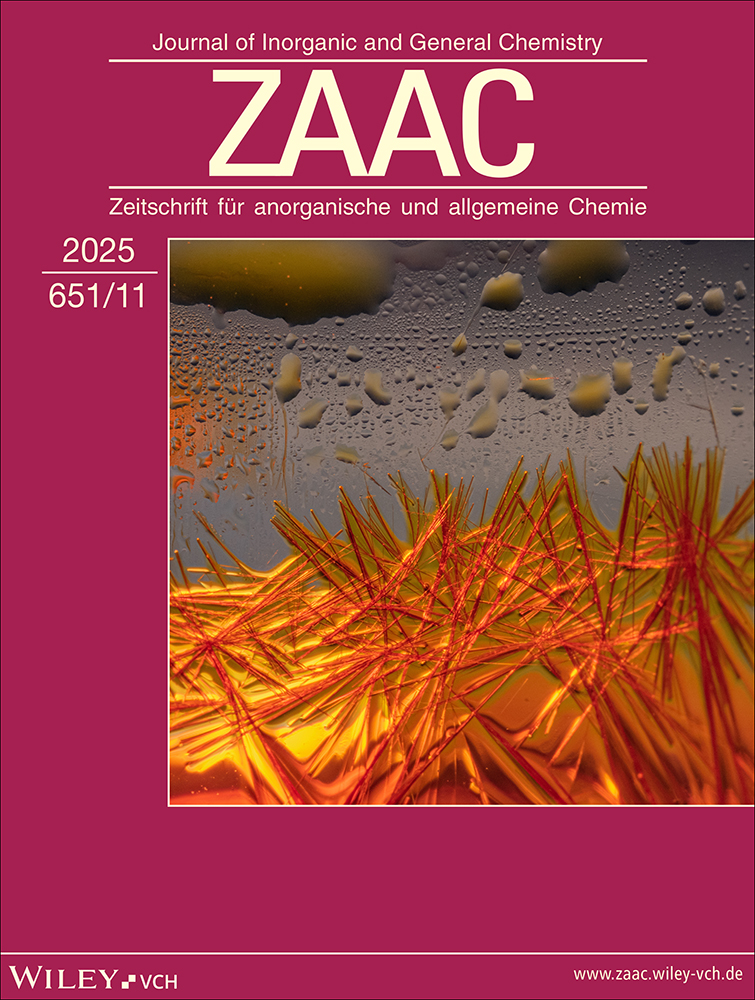Synthese, Kristallstruktur und Eigenschaften von Phosphor(V)-nitridimid HP4N7
Abstract
dePhasenreines HP4N7 wurde durch thermische Kondensation der molekularen Vorläufer-Verbindung (NH2)2P(S)NP(NH2)3 bei 750 °C in geschlossenen Quarzampullen als feinkristalliner, hydrolysestabiler Feststoff erhalten. Die Kristallstruktur wurde auf der Basis von Synchrotron-Röntgen-Pulverdaten (NSLS Brookhaven, Beamline X7A) mit Direkten Methoden gelöst und nach dem Rietveld-Verfahren verfeinert (HP4N7, P21/a, a = 1507,95(2), b = 480,304(6) c = 710,722(8)pm, β = 92,191(1)°, Z = 4, 1689 Reflexe, wRp = 0,082, Rp = 0,063, RF = 0,038). Charakteristisches Strukturelement in HP4N7 sind PN4-Tetraeder, die über gemeinsame Ecken und Kanten zu einer Raumnetzstruktur verknüpft sind. Dabei verbrücken fünf Siebtel aller N-Atome jeweils zwei, die restlichen N jeweils drei benachbarte P miteinander. Das IR-Spektrum von HP4N7 zeigt eine intensitätsstarke N–H-Valenzschwingungsbande bei 3089 cm–1. Im 31P-MAS-NMR-Spektrum von HP4N7 wird ein Signal bei –26 ppm beobachtet. HP4N7 ist in nichtoxidierender Atmosphäre bis etwa 800 °C stabil, darüber spaltet NH3 ab und es entsteht P3N5.
Abstract
enSynthesis, Crystal Structure, and Properties of Phosphorus(V) Nitride Imide HP4N7
Pure HP4N7 was obtained as a fine crystalline solid which is resistant to hydrolysis. The compound was synthesized by thermal condensation at 750 °C in sealed quartz ampoules starting from the molecular precursor compound (NH2)2P(S)NP(NH2)3. The crystal structure was solved by direct methods and refined by a Rietveld algorithm on the basis of synchrotron X-ray powder diffraction data which have been collected at the NSLS Brookhaven, beamline X7A (HP4N7, P21/a, a = 1507.95(2), b = 480.304(6) c = 710.722(8)pm, β = 92.191(1)°, Z = 4, 1689 reflections, wRp = 0.082, Rp = 0.063, RF = 0.038). In HP4N7 there are PN4-tetrahedra as characteristic structural motifs which are connected through common edges and corners resulting in a three-dimensional network structure. Two out of seven nitrogen each are bridging two and the remaining N are bridging three neighbouring P atoms. Solid state IR spectroscopy of HP4N7 reveals a strong N–H stretching vibration at 3089 cm–1. The 31P MAS NMR spectrum shows one signal at –26 ppm. In a nonoxidizing atmosphere HP4N7 is stable up to 800 °C. Above that temperature NH3 eliminates and P3N5 is formed.




